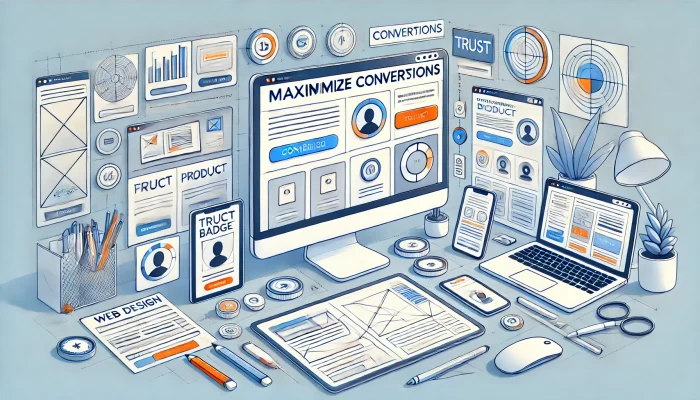10 Proven Web Design Tips to Skyrocket Conversions. One of the key components in any online strategy is website conversion optimization. A good design looks nice but also works. The layout and functionality of the site must always guide the user into the action that the site owner wants them to take, whether buying, signing up, or filling in a contact form. Here are some practical web design tips that help to maximize conversions and keep your site running at its best.
10 Proven Web Design Tips to Skyrocket Conversions
Table of Contents

Meta Description: Discover 10 proven web design tips to skyrocket conversions. Learn how to optimize your website for better engagement and higher results.
10 Proven Web Design Tips to Skyrocket Conversions
1. Simplify Navigation
Complex navigation can confuse visitors and increase bounce rates. A clean, intuitive menu structure ensures users can quickly find what they want. Stick to straightforward labels and group-related pages under clear categories.
Pro Tips:
- Limit your primary navigation to 5-7 main options.
- Include a search bar to assist users in finding specific content.
2. Optimize for Mobile Users
With over half of web traffic from mobile devices, a responsive design is non-negotiable. Ensure your site adapts seamlessly to different screen sizes and loads quickly on mobile devices.
Mobile Optimization Checklist:
- Use touch-friendly buttons and menus.
- Test your site on various devices and browsers.
- Minimize pop-ups that disrupt mobile users.
3. Focus on Fast Load Times
Speed up your website to keep visitors interested and improve SEO-the longer a page takes to load, the greater the likelihood of visitors abandoning it.
Speed-Boosting Strategies:
- Compress images without losing quality.
- Use a content delivery network (CDN).
- Minimize JavaScript and CSS files.
4. Use Clear and Compelling CTAs
A strong call to action is what makes conversions. The CTA should be visible, specifically, and action oriented. Phrases like “Get Started Today,” “Claim Your Free Trial,” or “Download Now” will work effectively.
CTA Placement Tips:
- Position CTAs above the fold and at the end of pages.
- Use contrasting colors to make them stand out.
- Ensure the language aligns with your audience’s intent.
5. Implement Visual Hierarchy
Visual hierarchy in designs guides visitors to the key features. Size, color, and placement draw attention to key information, with the most important information being larger, often in a brighter color, and placed higher up the page.
Best Practices for Visual Hierarchy:
- Use larger fonts for headlines.
- Place the most important content at the top of the page.
- Utilize whitespace to reduce clutter and enhance focus.
6. Optimize Forms for Simplicity
Lengthy or complicated forms can deter users. Keep forms simple and only request essential information.
Form Optimization Tips:
- Use autofill features where possible.
- Include progress bars for multi-step forms.
- Highlight mandatory fields clearly.
7. Use High-Quality Visuals
Invest in professional visuals, as images and videos greatly enhance engagement. Poor-quality media, unfortunately, does the exact opposite.
Content Ideas:
- Demonstration videos for products.
- Real photos of your team or workspace.
- Infographics to explain complex ideas.
8. Enable Live Chat Support
Proffering instant aid through live chat may enhance user experience and speed up conversions, as many of the visitors are most likely to act when their queries are answered immediately.
Tips for Effective Live Chat:
- Use AI chatbots for 24/7 support.
- Personalize responses whenever possible.
- Offer proactive assistance, such as “Need help choosing a plan?”
9. A/B Test Regularly
Testing different design elements helps identify what works best for your audience. Experiment with various layouts, CTAs, colors, and copy to find optimal combinations.
Elements to Test:
- Button colors and sizes.
- Placement of CTAs.
- Headline variations.
10. Keep Branding Consistent
Consistent branding builds trust, making the site memorable. You should use the same color palettes, typography, and tone of voice throughout all pages.
Checklist for Brand Consistency:
- Use a cohesive logo and favicon.
- Align your website design with your social media profiles.
- Maintain a uniform tone across blog posts, product descriptions, and emails.
11. Prioritize Accessibility
This expands the audience base for your website and even helps you comply with legal requirements because your website is made available to users with disabilities.
Accessibility Tips:
- Add alt text to all images.
- Use keyboard-navigable menus.
- Choose readable fonts and adequate color contrast.
12. Build Trust with a Secure Site
Security plays a major role in user trust. A secure website reassures visitors that their data is safe.
How to Improve Security:
- Use HTTPS encryption.
- Display trust seals.
- Offer secure payment options.
FAQs 10 Proven Web Design Tips to Skyrocket Conversions
What is the importance of web design in conversions?
Web design directly impacts user experience. A well-structured, visually appealing website keeps users engaged and encourages them to take action.
How can I make my CTAs more effective?
Use action-oriented language, make them visually distinct, and place them strategically where users are most likely to convert.
Does mobile optimization really impact conversions?
Yes! Mobile users account for a large portion of web traffic. A mobile-friendly site ensures a smooth user experience, which can boost conversions significantly.
Why is page speed crucial for conversions?
Slow-loading pages frustrate users, leading to higher bounce rates. Faster sites keep users engaged and encourage them to complete their desired actions.
How often should I update my website design?
Evaluate your design at least annually or whenever there are significant changes in user behavior, technology, or your brand’s focus.
